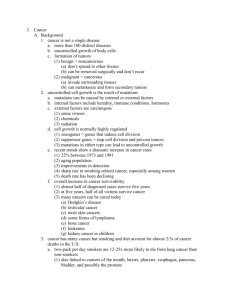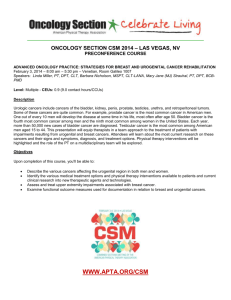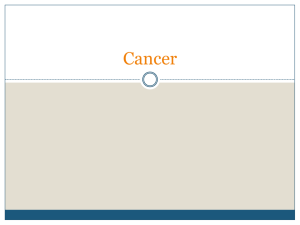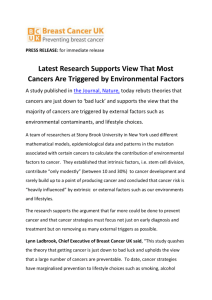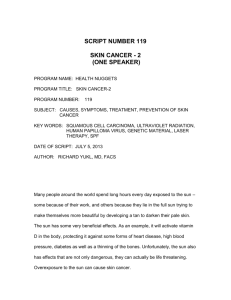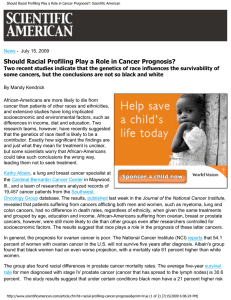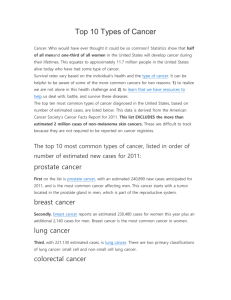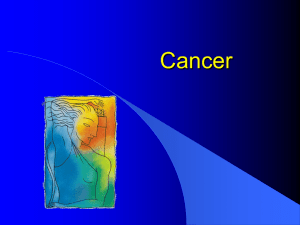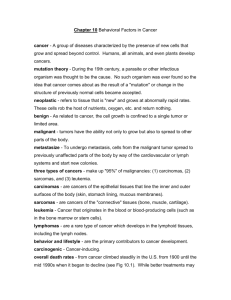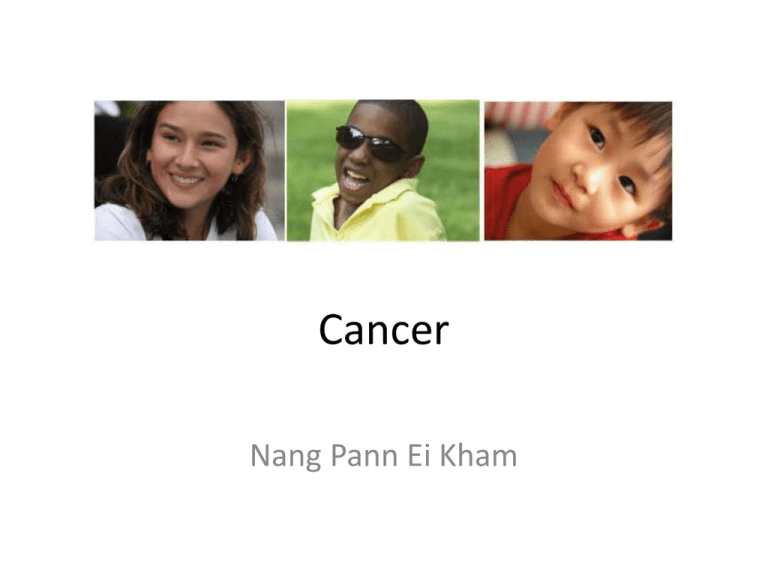
Cancer
Nang Pann Ei Kham
What is cancer?
• Definition
– a term used for diseases in which abnormal cells
divide without control and are able to invade other
tissues
• Cancer cells spread to other parts of the body
through the blood and lymph systems
• Cancer is not just one disease but many diseases
• More than 100 different types of cancer
Source: National Cancer Institute
Main Categories
• Carcinoma - cancer that begins in the skin or in tissues that
line or cover internal organs. There are a number of
subtypes of carcinoma: adenocarcinoma, basal cell
carcinoma, squamous cell carcinoma,transitional cell
carcinoma.
• Sarcoma - cancer that begins in bone, cartilage, fat, muscle,
blood vessels, or other connective or supportive tissue.
• Leukemia - cancer that starts in blood-forming tissue such
as the bone marrow and causes large numbers of abnormal
blood cells to be produced and enter the blood.
• Lymphoma and myeloma - cancers that begin in the cells
of the immune system.
• Central nervous system cancers - cancers that begin in the
tissues of the brain and spinal cord.
Causes
- Cigarette smoking
- Poor diet
- Physical inactivity
- Occupational exposures
- Viruses and other
biological agents
- Reproductive factors
- Alcohol
Cancer
High risk populations
- Poor
- Less educated
- Racial and ethnic
minorities
- Persons with a
family history of
cancer
- Elderly
Consequences
- High health care costs
for treatment
- Lost work productivity
- Insurance denial
- Disability
- Psychosocial problems
- Treatment complications
(eg. Increased risk of
second cancers)
- Premature mortality
Cancer: causes, consequences, and high-risk populations
Source: Chronic disease epidemiology and control
Cancer staging
• Based on the size or extent of the primary (main)
tumor and whether it has spread to other areas of the
body.
• Summary staging (in situ, local, regional, and distant) is
used for descriptive and statistical analysis of tumor
registry data.
• Cancer cells are present only in the layer of cells where
they developed and have not spread, the stage is in
situ.
• If penetrated beyond the original layer of tissue, the
cancer is invasive and categorized as local, regional, or
distant stage based on the extent of spread
TNM staging
• Assesses tumors in three ways:
– extent of the primary tumor (T)
– Absence or presence of regional lymph node involvement (N)
– Absence or presence of distant metastases (M).
Once the T, N, and M categories are determined, a stage of 0, I, II,
III, or IV is assigned,
– stage 0 - in situ,
– stage I - early
– stage IV - the most advanced disease.
• Some cancers have alternative staging systems (e.g.,
leukemia).
Facts
• Mortality
– In 2014, about 585,720 Americans are expected to die of
cancer (almost 1,600 people/day)
– Cancer: second most common cause of death in the US,
exceeded only by heart disease
• Survival
– 5-year relative survival rate for all cancers diagnosed
between 2003 and 2009 is 68%, up from 49% in 1975-1977
– improvement in survival reflects both progress in
diagnosing certain cancers at an earlier stage and
improvements in treatment
– Survival statistics vary greatly by cancer type and stage at
diagnosis.
Source: American Cancer Society- Cancer Facts and Figures 2013
New cancer cases
• 2010: more than one-half of all new cancerscancers of the prostate, female breast, lung,
and colon/rectum.
• American Cancer Society projections:
– 1,529,560 new cases of cancer in 2010
– 222,520 cases of lung cancer
– 217,730 cases of prostate cancer
– 209,060 cases of female breast cancer
– 142,570 cases of colon/rectum cancer
Source: National Cancer Institute, Cancer Trends Progress Report 2011/2012
update
All Cancers Combined
Incidence Rates* by State, 2010
Treatment
• Types: Surgery, chemotherapy, radiation therapy,
targeted therapy, immunotherapy, hyperthermia,
stem cell transplant, photodynamic therapy, lasers,
blood product donation and transfusion
• Complementary and Alternative Medicine: dietary
supplements; mind, body and spirit; herbs, vitamins
and minerals
• Palliative or Supportive Care: focuses on helping
patients get relief from symptoms caused by serious
illness – things like nausea, pain, fatigue, or
shortness of breath
Side Effects
• Physical: Chemotherapy/Radiation effects;
pain; nausea & vomiting; fatigue; anemia;
lymphedema; infection; fertility and sexual
side effects
• Emotional: distress, anxiety, fear and
depression, coping with loss of a loved one
Source: American Cancer Society:
http://www.cancer.org/treatment/treatmentsandsideeffects/emotionalsideeffects/a
ttitudes-and-cancer
Costs of cancer
• Hidden costs of cancer: health insurance premiums and
nonmedical expenses (transportation, child or elder care,
housekeeping assistance, wigs, etc.)
• Cancer has the most devastating economic impact of any
cause of death in the world
• Worldwide economic costs of cancer: $895 billion (US)
• Cancer cost the United States an estimated $263.8 billion in
medical costs and lost productivity in 2010 (National
Institutes of Health)
• With the growth and aging of the population, prevention
efforts are important to help reduce new cancer cases,
human suffering, and economic costs
•
Source: ACS: Global cancer facts & figures 2nd edition
• The costs of direct medical care for cancer:
estimated to account for 5% of national health
care spending
• UnitedHealthcare, estimated that 11 percent of
its costs are for cancer care (IOM, 2013).
• National expenditures for cancer care
– $72 billion in 2004
– $125 billion in 2010
– Estimated to increase to $158 billion in 2020
ACA
• Expand public coverage by removing the Medicaid eligibility
categories and raising the income threshold.
• Allow all non-elderly, non-disabled citizens, and legal U.S.
residents with family incomes below 133 percent of the
federal poverty level (FPL), or about $30,000 per year for a
family of four, to be eligible for Medicaid benefits.
• Extends coverage to low-income, childless adults, providing
them with access to preventive care such as colon and
breast cancer screenings
• Anticipated that more people with cancer can be diagnosed
and treated at an earlier stage, thus increasing their chance
for survival.
Effective Cancer Prevention
• Reduced risk by:_
– avoiding tobacco
– limiting alcohol use
– limiting exposure to ultraviolet rays from the sun and
tanning beds
– eating a diet rich in fruits and vegetables
– maintaining a healthy weight
– being physically active
– seeking regular medical care
• Screening: cervical, breast and colorectal cancers
• Vaccine: HPV, Hepatitis B
– Source: CDC
Guidelines for the Early Detection of Cancer
• Breast cancer
– Yearly mammograms starting at age 40 and
continuing for as long as a woman is in good
health
– Clinical breast exam (CBE) about every 3 years for
women in their 20s and 30s and every year for
women 40 and over
– Breast self-exam (BSE) is an option for women
starting in their 20s
Colorectal cancer and polyps
• Beginning at age 50, both men and women
should follow one of these testing schedules:
• Tests that find polyps and cancer
–
–
–
–
Flexible sigmoidoscopy every 5 years
Colonoscopy every 10 years
Double-contrast barium enema every 5 years
CT colonography (virtual colonoscopy) every 5 years
• Tests that primarily find cancer
– Yearly fecal occult blood test (gFOBT)
– Yearly fecal immunochemical test (FIT) every year
– Stool DNA test (sDNA)***
Lung cancer
• If you meet all of the following criteria, might
be a candidate for screening:
– 55 to 74 years of age
– In fairly good health
– Have at least a 30 pack-year smoking history AND
are either still smoking or have quit smoking
within the last 15 years
Prostate cancer
• Starting at age 50, men should talk to a doctor
about the pros and cons of testing so they can
decide if testing is the right choice for them.
• If they are African American or have a father or
brother who had prostate cancer before age 65,
men should have this talk with a doctor starting
at age 45.
• If men decide to be tested, they should have the
PSA blood test with or without a rectal exam.
• How often they are tested will depend on their
PSA level.
A National Action Plan for Cancer
Survivorship
•
•
•
•
•
•
•
•
Achieve the cancer survivorship-related objectives in Healthy People 2010 that
include benchmarks for success in measuring improvements for addressing
ongoing survivor needs.
Increase awareness among the general public, policy makers, survivors, providers,
and others of cancer survivorship and its impact.
Establish a solid base of applied research and scientific knowledge on the ongoing
physical, psychological, social, spiritual, and economic issues facing cancer
survivors.
Identify appropriate mechanisms and resources for ongoing surveillance of people
living with, through, and beyond cancer.
Establish or maintain training for health care professionals to improve delivery of
services and increase awareness of issues faced by cancer survivors.
Implement effective and proven programs and policies to address cancer
survivorship more comprehensively.
Ensure that all cancer survivors have adequate access to high-quality treatment
and other post-treatment follow-up services.
Implement an evaluation methodology that will monitor quality and effectiveness
of the outcomes of initiatives.
Translational Researches
• Intervention Research: Accelerating the
Translation of Knowledge to Improve Cancer
Related Fatigue Outcomes
• The Reflected Light of Steve Jobs: A Brighter
Future for Pancreatic Cancer
• Viruses, Bacteria, and Cancer, or It’s Not All
Smoke and Sunlight
• http://www.youtube.com/watch?v=l3XeurTFc
y4&feature=youtu.be
• Thank you and Question?

